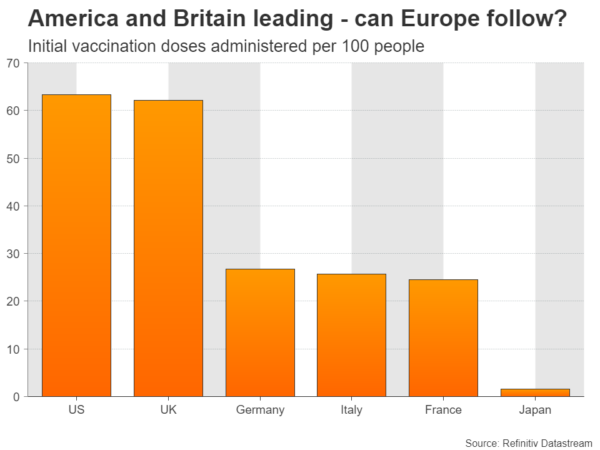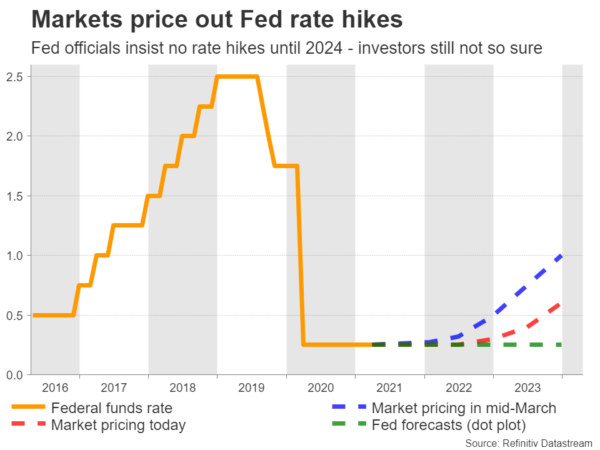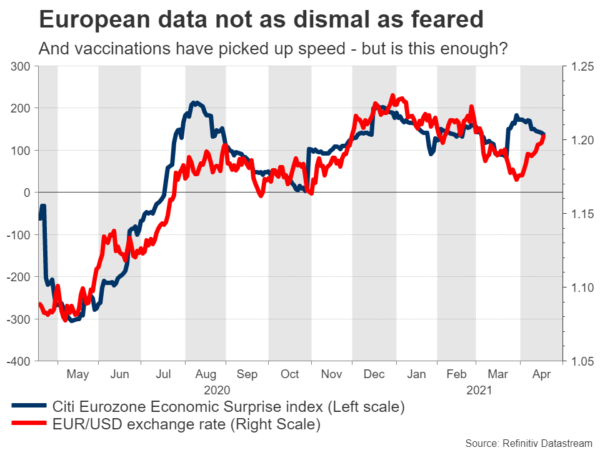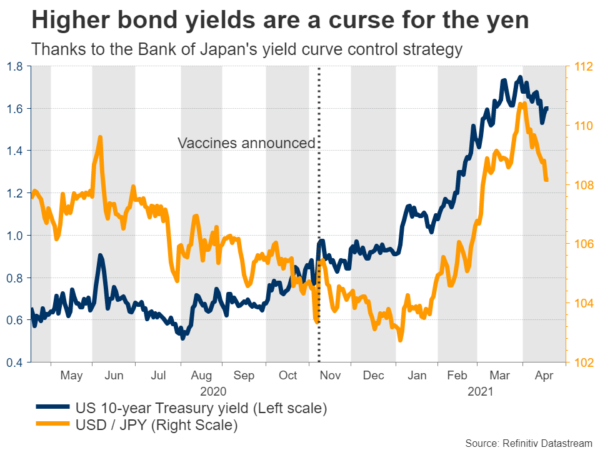The dynamics in the FX market have changed this year. The speed of vaccinations has turned into the most powerful element driving currency moves, as investors recalibrate their expectations for economic growth and the timeline of central bank rate increases. Britain and America have done better than Europe and Japan so far, though Europe seems to be closing the gap. Overall, the prospects for the dollar seem bright, but the same cannot be said for the yen.
How we got here
Just over a year ago, global markets were staring into a dark abyss. Entire nations had been locked down, an unemployment apocalypse was raging, and fear was king. But it turns out that even a global pandemic is no match when governments and central banks join forces to fight a crisis.
The combination of extravagant government spending and ultra-low interest rates was so incredibly powerful that it eclipsed everything else, restoring peace to financial markets. Once the vaccines were announced too, investors could finally see the light at the end of this nightmare and a sense of euphoria took over.
Fast forward to today. Most economies are healing their wounds, yet some are recovering faster than others, thanks to a divergence in the fiscal firepower deployed and the speed of their vaccination programs. In turn, that is being reflected in the performance of their currencies.
UK crowned vaccine champion
Britain has done exceptionally well in the immunization race. British authorities ‘bent’ several regulatory rules to expedite the approval of the vaccines, which allowed the country to place orders with manufacturers quickly. At this pace, the nation’s entire adult population will have received at least one shot by the middle of the summer.
Even though the economy has been struggling thanks to the prolonged shutdowns, the incredible speed of vaccinations has convinced investors that better days lie ahead. This has catapulted the pound higher this year, with fading expectations for Bank of England rate cuts and receding Brexit risks adding fuel to the rally.
Sadly though, political risks haven’t disappeared. Tensions in Northern Ireland have escalated lately, complicating EU-UK talks on border checks, and voices for another independence referendum are growing louder in Scotland.
But perhaps the main risk surrounding sterling is the quality of vaccinations. Most Britons have received the Oxford/AstraZeneca vaccine, which is less effective against the new variants. Hence, there’s still a threat of cases exploding again as Britons return from their vacations abroad.
Dollar comeback runs out of steam
America initially experienced a severe outbreak, yet its economy remained resilient throughout this calamity. The Fed acted boldly through its enormous asset purchases to ensure that the economic crisis did not mutate into another financial crisis, while Congress unleashed a landslide of federal spending.
The sheer amount of stimulus that’s been rolled out is simply unprecedented outside of wartime. Furthermore, the lockdowns of most American states were fewer and shorter compared to those in Europe, and the nation’s immunization program is firing on all cylinders. At this rate, most Americans will have received at least one vaccine shot by early summer.
It’s not just the impressive speed of US vaccinations, it’s also the quality. Unlike Britain, the US has deployed only the very best vaccines, which have proved effective against almost all variants so far. Therefore, America’s immunization program seems to be more ‘bulletproof’. It will probably be a stellar summer in economic data, as the colossal stimulus measures and all the pent-up demand from unchained consumers come together.
As such, markets have become convinced that the Fed will be forced to raise rates much earlier than planned to keep inflation under control. This breathed life back into the dollar, though the rally has cooled lately. The Fed’s leadership has been adamant that it will stick to its word not to raise rates prematurely, and that message seems to be finally resonating with investors, who have scaled back their bets for a rate hike next year.
Europe set to catch up, Japan left behind
Shortly after the pandemic rocked the world, Europe was being praised as having one of the most effective responses. Early lockdowns went into force while governments enacted powerful relief programs to support businesses and jobs. It seemed like the euro area would weather the storm better than anyone else.
Of course, it didn’t. The Eurozone was soon hit by a bigger wave of infections and the next round of shutdowns wasn’t accompanied by equally powerful relief measures. More importantly, Europe’s vaccine rollout was a catastrophe early on. European regulators were slow to authorize vaccines for use and the EU was slow to negotiate contracts with manufacturers, sparking supply problems and delays.
Naturally, this took the wind out of the euro’s sails as market participants concluded the Eurozone’s recovery would be lackluster, which ultimately translates into the European Central Bank being among the last to raise interest rates again. That said, the euro has staged a comeback lately, as the pace of vaccinations in Europe finally started to accelerate.
The yen has it even worse. The Japanese currency took a beating this year as yield differentials widened against it. Expectations for a robust global recovery are pushing foreign bond yields higher, but the Bank of Japan keeps a ceiling on domestic yields, making the yen less attractive from an interest rate differential perspective. The ecstatic mood in stock markets is also a curse for the defensive yen.
Sadly, Japan’s vaccine rollout has been even slower than Europe’s, and is unlikely to pick up. Even though the nation weathered the pandemic very well, with infections and deaths being far lower than most Western countries, it was very slow to give the regulatory green light to vaccines. Consequently, it lagged behind in placing its orders. Vaccinations have barely started, hence Japanese businesses and shoppers will live under the pandemic’s shadow for a while longer.
Dollar seems attractive, yen not so much
All told, it’s difficult to be pessimistic on the dollar. The Fed insists that it won’t raise rates prematurely, but ultimately, it might not have a choice if the US economy is running on all gears and inflation makes a comeback. Despite the rhetoric, the endgame is the Fed being among the first central banks to scale back its QE program, and then raise rates.
It’s equally difficult to be optimistic on the yen. Japan has fallen far behind in the vaccination race, and the Bank of Japan will probably be the last major central bank to move away from cheap-money policies. Outside of a new virus mutation that is highly resistant to the existing vaccines or some other shock that sparks panic in the markets, it is difficult to envision what can turn the yen’s fortunes around.
The pound and the euro rank somewhere in the middle. That said, the outlook for sterling seems brighter than the euro’s. Britain is miles ahead in immunizations, and unless one of the above-mentioned risks materializes, the Bank of England will likely begin to normalize policy far earlier than the European Central Bank.
In the end, faster vaccinations mean faster economic growth and faster rate increases. America is winning this game, Japan is losing it.
















